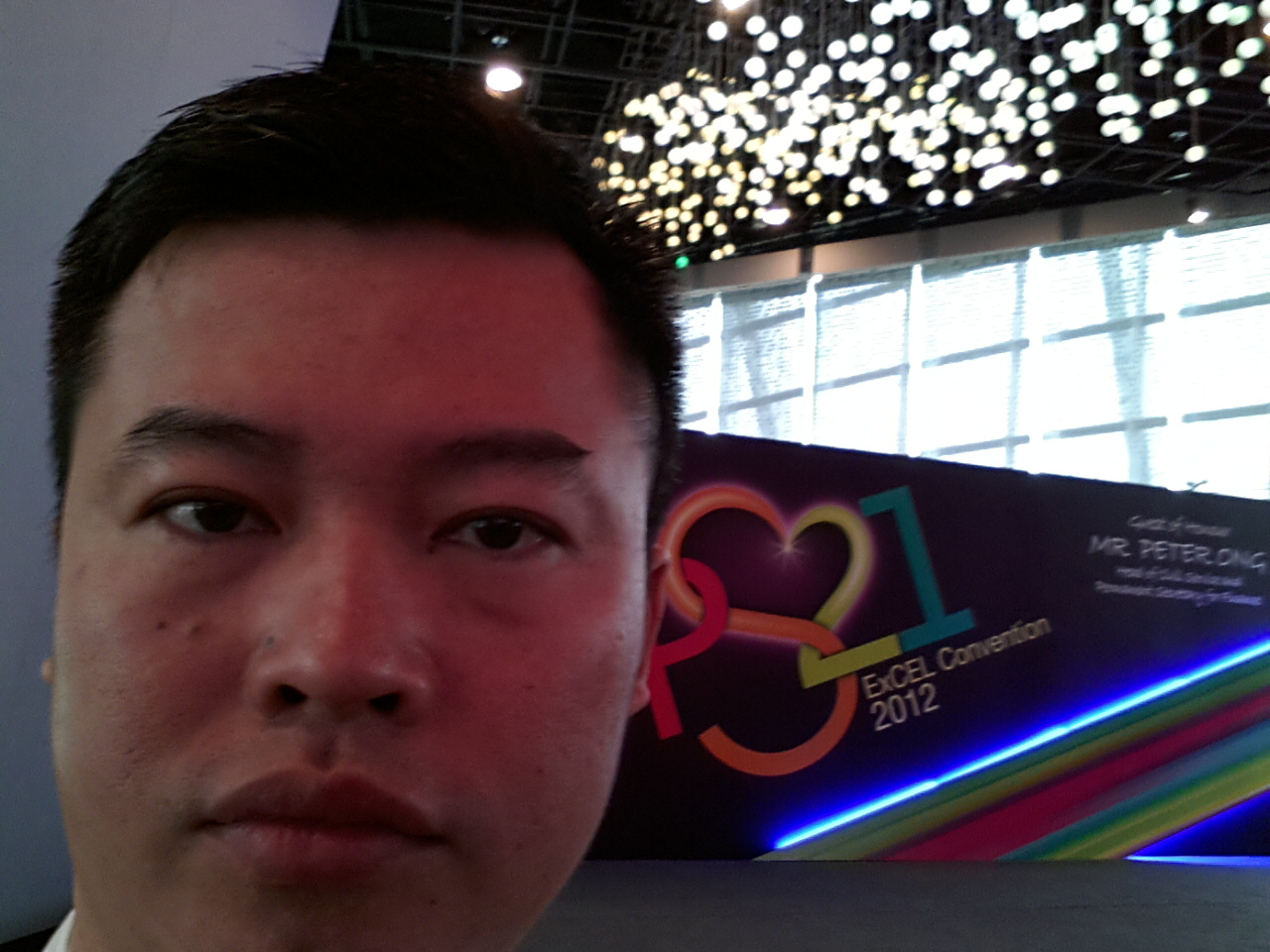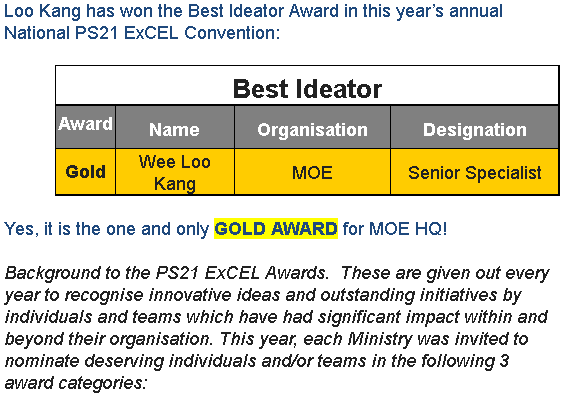Briefing Document: Open Educational Resources / Open Source Physics @ Singapore
1. Overview:
This document centers around the work of Loo Kang, a physics educator in Singapore recognized for his innovative use of open-source computer models (simulations) to enhance physics education. His efforts, largely self-directed, have led to significant improvements in student engagement, learning outcomes, and the accessibility of physics concepts. The document highlights his achievements, including awards, collaborations, and the impact of his work on local and international communities.
2. Key Themes:
- Open Educational Resources (OER) & Open Source Physics: Loo Kang champions the use of free, openly accessible resources, particularly computer simulations, in physics education. He leverages the work of the Open Source Physics (OSP) community, adapting and creating simulations using Easy Java Simulation (EJS) to make them customizable and relevant to the local curriculum. His driving philosophy is captured in his statement, "My dream is to provide quality physics education through open source physics so that teachers and students can explore, understand, describe, explain and predict physics phenomena modelled at no additional cost."
- Inquiry-Based Learning: Loo Kang's approach moves away from traditional "drill and practice" methods, emphasizing inquiry-based learning where students explore concepts through interactive simulations, taking on the role of scientists. This is exemplified by his "gravity-physics by inquiry" project, which allows students to collect, analyze, and visualize data related to abstract concepts such as gravitational forces.
- Technology-Enhanced Learning: The document strongly advocates for the use of technology, particularly computer models, as an effective tool for physics education. These models are viewed as appropriate laboratory environments that provide contextualized experiences, making abstract concepts more concrete and accessible for students. He has contributed or adapted more than 65 Physics simulations.
- Impact and Scalability: Loo Kang's work has had a notable impact on Singaporean schools and students and globally. His models are used in several schools, and his lesson packages have been used by many students and teachers. His work is also being incorporated into the Ministry of Education's teacher handbook and is having a global impact. His work is also shared openly and repurposed on Wikipedia. His creations are having an impact on the way physics is taught.
- Self-Directed Innovation and Professional Development: Loo Kang's project was developed largely through self-directed learning and a commitment to mastering necessary skills (like Java programming). He embodies a proactive approach to professional development, constantly seeking to improve teaching methods.
- Real-World Relevance: Loo Kang connects physics to everyday life, such as his analysis of the speed of a Ferrari in a car crash to make learning more relevant. He has also used his models to analyse real world events, making physics seem more practical.
3. Most Important Ideas & Facts:
- Loo Kang as an "Excellent Ideator": The core narrative is Loo Kang's recognition as an outstanding innovator in education. He is cited as "an excellent ideator who constantly seeks to find new ways of improving learning and teaching". He was awarded the PS21 ExCEL Awards Best Ideator (Gold) Award in 2012.
- Development of Computer Models: Loo Kang has contributed or adapted more than 65 physics simulations. He has created computer models for both O-Level and A-Level Physics. He was working toward impacting more than 100 schools in Singapore.
- 'Gravity-Physics by Inquiry' Project: This is his key project, winning a gold award at the Innergy Award 2012. It involves a series of computer models that enable students to engage in investigative data collection, analysis, and visualization of abstract concepts, such as Kepler's Laws of Planetary Motion, geostationary satellite orbits, and gravitational fields.
- Research-Validated Approach: His methods are based on research, with studies suggesting that computer models provide valuable contextualized experiences and lead to measurable educational gains. He references studies on inquiry learning (Hake, 1998), learning through simulations (Wee, 2012b) and computer models (Chee, Tan, Tan, & Jan, 2009; Christian & Esquembre, 2007; Hwang & Esquembre, 2003).
- Impact on Learning: His research suggests that computer models are appropriate laboratory environments that can provide contextualized experiences, (Wee, 2012b) essential for deepening students’ understanding through student-centric interactive learning (Wee, Chew, Goh, Tan, & Lee, 2012). Most importantly, physics comes "alive" and is meaningfully fun to inspire curiosity and imagination.
- Implementation in Schools: The "gravity-physics by inquiry" project has been implemented in at least 5 schools (River Valley High, Yishun Junior College, Serangoon Junior College, Anderson Junior College and Innova Junior College) with level-wide implementations. The use of his models promotes “cognitive apprenticeship” by encouraging students to function as scientists (Chee, 1995; Collins, Brown, & Newman, 1987; Jan, Chee, & Tan, 2010).
- Global Reach: Loo Kang actively shares his work through blogs, social media, and contributions to open-source repositories. His work has been recognized internationally, with a German documentary company requesting to use his simulations. His simulations are also used in Wikipedia. Professor Vasudeva Rao Aravind from Pennsylvania State University is cited as calling him a world leader-contributor of ideas on computer models.
- Low-Cost Accessibility: The models are free of charge, creating low barriers to adoption, which is important to promote greater equity in access to quality education.
- MOE Recognition and Collaboration: His efforts have been recognized by the Ministry of Education, leading to collaborations on teacher handbooks and integration of his models into the national curriculum.
- Social Media Usage: Loo Kang uses Twitter as a back channel to enrich discussions. He actively blogs and twits on physics education matters, with many followers from around the world.
4. Supporting Quotes:
- "His ideas to leverage on computer models for interactive physics learning is made possible through his contributions with the vision to bring realistic, customized (Wee & Mak, 2009) and research-validated computer models (also known as simulations) into the hands of ordinary students."
- "His research suggests computer models are appropriate laboratory environments that can provide contextualized experience...essential for deepening students’ understanding through student-centric interactive learning."
- "Most importantly, physics comes "alive" and is meaningfully fun to inspire curiosity and imagination."
- "The best suggestion is the gravity-physics by inquiry, a series of computer models...to allow the investigative data collection, analysis and visualization of abstract and difficult concepts for students."
- "My dream is to provide quality physics education through open source physics so that teachers and students can explore, understand, describe, explain and predict physics phenomena modelled at no additional cost."
- "Physics is abstract, and without any tools for [the students] to interact with these phenomena, it’d be practically impossible for them to have a deeper understanding.”"
5. Conclusion:
Loo Kang's work demonstrates the power of open educational resources, inquiry-based learning, and technology to transform physics education. His self-directed approach to innovation and commitment to sharing his resources make him a model for educators seeking to enhance student engagement and promote a deeper understanding of scientific concepts. His contributions have not only benefited students and teachers in Singapore, but also have reached a global audience, underscoring the impact of freely accessible, well-designed educational materials.
About
Public Service 21 ExCEL Awards Best Ideator 2012
Nomination
Nomination for PS21 Excel Awards Best Ideator 2012
Nomination for PS21 Excel Awards Best Ideator 2012
 |
| Nomination for PS21 Excel AwardsBest Ideator 2012 |
Nomination thanks to Latha for the email nomination, Yew Meng and Seau Yoon for vetting, Victor of the impact section beefing up :)Summary Finali)
Loo Kang an excellent ideator who constantly seeks to find new ways of improving learning and teaching. He lives the ethos of the teaching profession (MOE, 2010) and deepens his specialized skills and knowledge to create new open source physics computer models to benefit anyone, anywhere in the world, for free. His ideas to leverage on computer models for interactive physics learning is made possible through his contributions with the vision to bring realistic, customized (Wee & Mak, 2009) and research-validated computer models (also known as simulations) into the hands of ordinary students. To date, he has contributed or adapted more than 65 Physics simulations for use in our local curriculum.His research suggests computer models are appropriate laboratory environments that can provide contextualized experience, (Wee, 2012b) essential for deepening students’ understanding through student-centric interactive learning (Wee, Chew, Goh, Tan, & Lee, 2012). Most importantly, physics comes "alive" and is meaningfully fun to inspire curiosity and imagination. (ii)
His key project “gravity-physics by inquiry” won the gold award at the Innergy award 2012 and was recognised for his innovative idea, a fundamental breakthrough by creating significant value-add previously not possible.
His active inquiry lesson packages with computer models has been scaled up in eduLab project with at least 5 schools (River Valley High, Yishun Junior College, Serangoon Junior College, Anderson Junior College and Innova Junior College) in level-wide implementations of inquiry laboratory and flip classroom e-learning. His research suggests students and teachers not only believed in the usefulness of these computer models but there is measurable educational gains (Hake, 1998) even for first time implementations. This has led to future collaboration with principal master teacher (Physics) who will extend Loo Kang’s ideas on more than 65 computer models into the ministry of education academy of Singapore teacher’s Handbook for Teaching Secondary Physics (MOE, 2011, pp. 65-124) Part II: Knowledge of Secondary Physics Curriculum with computer models, a key initiative by the AST physics subject chapter and CPDD.Summary (Good to Go)
(i)
Loo Kang an excellent ideator who constantly seeks to find new ways of improving learning and teaching. He lives the ethos of the teaching profession (MOE, 2010) and deepens his specialized skills and knowledge to create new open source physics computer models to benefit anyone, anywhere in the world, for free. His ideas to leverage on computer models for interactive physics learning is made possible through his contributions with the vision to bring realistic, customized (Wee & Mak, 2009) and research-validated computer models (also known as simulations) into the hands of ordinary students, in any part of the world. To date, he has contributed or adapted more than 65 Physics simulations for use in our local curriculum.
His research suggests computer models are appropriate laboratory environments that can provide contextualized experience, (Wee, 2012b) essential for deepening students’ understanding through student-centric interactive learning (Wee, Chew, Goh, Tan, & Lee, 2012). Most importantly, physics comes "alive" and is meaningfully fun to inspire curiosity and imagination.(ii)
His key project “gravity-physics by inquiry” won gold award at the Innergy award 2012 and was recognised for his innovative idea that was a fundamental breakthrough by creating significant value-add previously not possible.
His active inquiry lesson packages with computer models has been scaled up in eduLab project with at least 5 schools (River Valley High, Yishun Junior College, Serangoon Junior College, Anderson Junior College and Innova Junior College) in level-wide implementations of inquiry laboratory and flip classroom e-learning. His research suggests students and teachers not only believed in the usefulness of these computer models but there is educationally significant gains (Hake, 1998) even for first time implementations.
This has led to future collaboration with principal master teacher (Physics) who will extend Loo Kang’s ideas on more than 65 computer models into the ministry of education academy of Singapore teacher’s Handbook for Teaching Secondary Physics (MOE, 2011, pp. 65-124) Part II: Knowledge of Secondary Physics Curriculum with computer models, a key initiative by the physics subject chapter.
Summary (Original)(i) Loo Kang is the best ideator because he lives the ethos of the teaching profession (MOE, 2010) and deepens his specialized skills and knowledge to create new open source physics computer models to benefit anyone for free. His ideas to leverage on computer models for interactive physics learning is made possible through his contributions with the vision to bring realistic, customized (Wee & Mak, 2009) and research-validated computer models (also known as simulations) into the hands of ordinary students, in any part of the world.. His research suggests computer models are appropriate laboratory environments that can provide contextualized experience, (Wee, 2012b) essential for deepening students’ understanding through student-centric interactive learning (Wee, Chew, Goh, Tan, & Lee, 2012). Most importantly, physics comes "alive" and is meaningfully fun to inspire curiosity and imagination. (ii) His key project “gravity-physics by inquiry” won gold award at the Innergy award 2012 and was recognised for his innovative idea that was a fundamental breakthrough by creating significant value-add previously not possible. His active inquiry lesson packages with computer models has been scaled up in eduLab project with at least 5 schools (River Valley High, Yishun Junior College, Serangoon Junior College, Anderson Junior College and Innova Junior College) in level-wide implementations of inquiry laboratory and flip classroom e-learning. His research suggests students and teachers not only believed in the usefulness of these computer models but there is educationally significant gains (Hake, 1998) even for first time implementations. This has led to future collaboration with principal master teacher (Physics) who will extend Loo Kang’s ideas on more than 65 computer models into the ministry of education academy of Singapore teacher’s Handbook for Teaching Secondary Physics (MOE, 2011, pp. 65-124) Part II: Knowledge of Secondary Physics Curriculum with computer models, a key initiative by the physics subject chapter.Contribution: (40%) Loo Kang’s idea contributions are forward looking and concise in the formal MOE meetings for example, notably using Twitter as a back channel to allow everyone to contribute ideas to enrich discussions during meetings. Informally, he actively blogs and twits on Physics education matters especially on those low barriers to adoption tools that can be scale up to schools, getting about 500 visitors all over the world per day.
Ideas beyond his job scope includes
1. Analysis of the speed of the Ferrari 599 GTO that crashed a Taxi causing 3 dead, 2 injured in Bugis S'pore - 12May2012, using current affairs to make physics relevant to life. http://weelookang.blogspot.sg/2012/05/what-evidence-of-speed-ferrari-was.html
2. Publishing in Physics education peer-reviewed journals to scale up innovative use of tools in education.
- a) Wee L.K., Ning H.T. (201X) Vernier Callipers and Micrometer Computer Model using Easy Java Simulation XX(X), XXX (pending submission)
- b) Wee L.K., Goh G.H. (201X) Earth-Moon System using Easy Java Simulation (pending submission)
- c) Wee L.K., Goh G.H., Kwan Y.M., Charles Chew (201X) Geostationary Earth Orbit Satellite Model using Easy Java Simulation XX(X), XXX (manuscript under review)
- d) Wee L.K., Charles Chew, Goh G.H., Lee T.L., Samuel Tan (2012) Using Tracker as a Pedagogical Tool for Understanding Projectile Motion Physics Education, 47(4): 448. arXiv:1206.6489 [pdf]
- e) Wee, L. K. (2012). One-dimensional collision carts computer model and its design ideas for productive experiential learning.Physics Education, 47(3): 301. http://www.compadre.org/osp/items/detail.cfm?ID=11802 [Draft PDF] arXiv:1204.4964 [pdf]
- f) Wong, D., Sng, P. P., Ng, E. H., & Wee, L. K. (2011). Learning with multiple representations: an example of a revision lesson in mechanics. Physics Education, 46(2), 178. http://www.compadre.org/OSP/items/detail.cfm?ID=10817 [Draft PDF]arXiv:1207.0217 [pdf]
3. Publish computer models on Open Source Physics (Christian, Esquembre, & Barbato, 2011) http://www.compadre.org/osp/
- a) Wee, L. K. (2012). Geostationary Earth Orbit Satellite Model. [Computer software] Retrieved fromhttp://www.compadre.org/Repository/document/ServeFile.cfm?ID=11775&DocID=2634
- b) Wee, L. K. (2012). Tracker Video Analysis: Bouncing Ball. [worksheet, video and trk file] Retrieved fromhttp://www.compadre.org/Repository/document/ServeFile.cfm?ID=11705&DocID=2583
- c) Hwang, F.-K., & Wee, L. K. (2011). Direct Current Electrical Motor Model[Computer software]. Retrieved fromhttp://www.compadre.org/Repository/document/ServeFile.cfm?ID=11529&DocID=2476
- d) Hwang, F.K, & Wee, L.K. (2011). Newton's Cradle Applet [Computer software]. Retrieved July 26, 2011, fromhttp://www.phy.ntnu.edu.tw/ntnujava/index.php?topic=2195.0
- e) Wee, L.K (2011). Up and Down Bouncing Ball Model [Computer software]. Retrieved April 23, 2011, fromhttp://www.compadre.org/osp/document/ServeFile.cfm?ID=10817&DocID=2186&Attachment=1
- f) Wee, L.K., & Esquembre, F. (2010). Lorentz force on a current carrying wire java applet [Computer software]. Retrieved April 23, 2011, from http://www.compadre.org/Repository/document/ServeFile.cfm?ID=10543&DocID=2053
- g) Hwang, F.K., & Wee, L.K. (2010). Cyclotron in 3D Model (Version 10/12/2010) [Computer software]. Retrieved April 23, 2011, from http://www.compadre.org/osp/items/detail.cfm?ID=10527
- h) Hwang, F.K., Wee, L.K. & Christian, W (2009). Vernier Caliper Model [Computer software]. Retrieved April 23, 2011, fromhttp://www.compadre.org/Repository/document/ServeFile.cfm?ID=9707&DocID=1445
- i) Hwang, F.K., Wee, L.K. & Christian, W (2009). Micrometer Model [Computer software]. Retrieved April 23, 2011, fromhttp://www.compadre.org/Repository/document/ServeFile.cfm?ID=9422&DocID=1315
- j) Hwang, F.K. & Wee, L.K (2009). Blackbody Radiation Spectrum Model [Computer software]. Retrieved April 23, 2011, fromhttp://www.compadre.org/Repository/document/ServeFile.cfm?ID=9387&DocID=1292
Loo Kang’s contributions is affirmed by Director General Education, Permanent Secretaries and senior management on 03rd May 2012, during an invited PS21 presentation sharing on Gravity-Physics by Inquiry (MOE, 2012a). The audience congratulates him on his passion and excellent idea-implementation on computer models for the betterment of the world. Many of the Open Source Physics Professors thank Loo Kang for his contributions in emails and face to face meeting (Wee, 2010a, 2012a) with face book message (Figure 1) being the most celebrated from Vasudeva Rao Aravind, Professor of Physics from Pennsylvania State University, USA .
| Figure 1. Vasudeva Rao Aravind, Professor of Physics from Pennsylvania State University, USA recognising Loo Kang as a world leader-contributor of ideas on computer models |
Idea Quality:
The best suggestion is the gravity-physics by inquiry, a series of computer models (Figure 2, Figure 3, Figure 4 and Figure 5) to allow the investigative data collection, analysis and visualization of abstract and difficult concepts for students. This suggestion is insightful and innovative especially when considering the financial cost involved in sending space shuttles full of students to Earth’s outer atmosphere, a potentially dangerous journey and what others expensive or free simulations has not done or cannot do yet.
The experimentation is high as Loo Kang need to self direct (Gibbons, 2002) his own learning to master Java programming language, research on suitable pedagogy of inquiry (Christian & Esquembre, 2007; Jackson, Dukerich, & Hestenes, 2008; McDermott, Shaffer, & Rosenquist, 1995; Scherr, 2003; Wee, Lee, & Goh, 2011; C. E. Wieman, Adams, Loeblein, & Perkins, 2010; Carl E. Wieman, Adams, & Perkins, 2008) suited for use with computer models (Chee, Tan, Tan, & Jan, 2009; Christian & Esquembre, 2007; Hwang & Esquembre, 2003) and appropriate user interface design (Adams et al., 2008) while collaborating with computational physicists from around the world.
The risk-taking is also high as much of the implementation of the suggestion was done in his free time since 2006, in a largely ground-up idea without structured and formalized top-down support. It is only in 2012 that the fruits of his suggestion was materialized in a National Research Fund (NRF) & MOE funded NRF2011-eduLab 001 Java Simulation Design for Teaching and Learning project (MOE, 2012b; Wee, 2010b) with him as a co Principal Investigator and an INNERGY GOLD AWARD 2012 win for gravity-physics by inquiry (MOE, 2012a) with him as the idea leader.
The suggestion improve existing process of physics education schooling practices by creating computer models as tools for active scientific inquiry and interactive engagement (Hake, 1998) that improves the research pre-post test scores with an Cohen’s effect size of about 0.3 (educational significant) even for first time implementation by the 25 teachers in the 5 schools. The benefits are especially heightened when comparing to traditional word problem solving dominated lecture and tutorial system in most classrooms in the pre-universities centers especially when teaching gravity concepts because of heigthened difficulties to collect astromonical data from Singapore using telescopes at night.
Impact ( Final)Impact on Singapore Schools
Loo Kang’s models are free of charge and presents low cost barriers to adoption. His Gravity-Physics by Inquiry Lesson Package (Figure 6) has been used by about 1000 students and 25 teachers, across 5 schools in Singapore. (Table 1) Loo Kang’s research his high returns on investments especially when there has been no funding in his creation of a suite of 65 computer models which can be used for the O-Level and A-Level Physics. He is working on systematically impacting the all 100+ secondary schools through incorporating computer models into the Singapore teacher’s Handbook for Teaching Secondary Physics (MOE, 2011, pp. 65-124) Part II: Knowledge of Secondary Physics Curriculum. Impact on Singapore Students Loo Kang’s models encourages cognitive apprenticeship (Chee, 1995; Collins, Brown, & Newman, 1987) by encouraging students to function like scientists (Jan, Chee, & Tan, 2010) in their guided inquiry learning.
His work allows students to make sense of large physical systems (such as Solar System Model (Figure 2), Earth and Satellite Model (Figure 3), Two Mass Model science laboratory toolkit (Figure 4) and Moon-Earth Model (Figure 5)), through computer visualization.Impact on Singapore Teachers Loo Kang’s work presents an innovative approach to the teaching of Physics as an alternative to the traditional ‘drill and practice’ approach. His innovative approach is aligned to MOE’s strategic focus in preparing learners for the 21st Century (Plomp, 2011). His work has received commendation from MOE senior management and they have encouraged him to continue creating models to help ordinary teachers be more effective in their teaching of Physics.
| Figure 7.MOE ASPIRE magazine (May 2012 issue). L to R: Yew Meng KWAN, Loo Kang WEE, Charles CHEW (absent: Jimmy Giam Hwee GOH). Picture by Wei Hao HO, Artwork by Claire Zixin HONG |
| Figure 8.模拟软件让课堂“动”起来 an article by王珏琪 http://www.zaobao.com.sg/sp/sp120330_024.shtml on lianhe zaobao the impact of the Open Source Physics eduLab project lead by Loo Kang (30th March 2012). Scanned newspaper by Tat Leong |
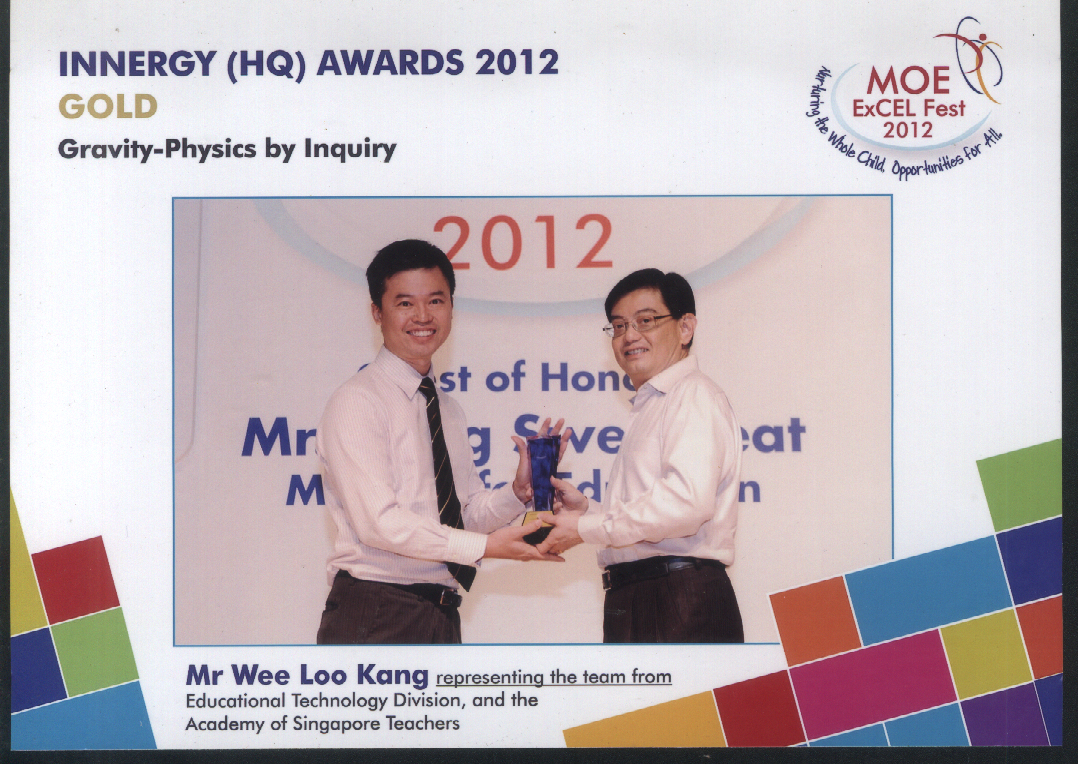 |
| Figure 9a.Loo Kang receiving the gold innergy award from Minister Heng, photo (left) and 43 seconds of the Excel Fest 2012 Highlights video http://www.youtube.com/watch?v=RCYTwADn8sE (right) |
 |
| Figure 9b.Loo Kang receiving the gold innergy award from Minister Heng, photo (left) and 43 seconds of the Excel Fest 2012 Highlights video http://www.youtube.com/watch?v=RCYTwADn8sE (right) |
He has conducted many workshops and conference presentations to help teachers adopt the meaningful use of computer models in physics education. His significant contribution in the professional development of the Physics fraternity can be seen in a series of feature articles on his work. For example, MOE ASPIRE magazine (May 2012) (Figure 7), Lianhe Zaobao newspaper feature on Open Source Physics (Figure 8) and INNERGY GOLD award 2012 presented by Minister of Education, Heng Swee Keat (Figure 9). Impact on Singapore’s and the International Physics Community Loo Kang has made significant contribution to Physics education in Singapore and globally. This is evident from his dissemination of his lesson packages and his active engagement on social media. (Table 1) He also regularly contributes to the digital libraries at Open Source Physics and NTNU Java Virtual Lab and 3 scholarly articles in Physics Education Journal.
| Figure 10a.As an example, too many to list, Wikipedia contributions by Loo Kang are used in many different pages of wikipedia and many different languages as well.http://commons.wikimedia.org/wiki/File:Geostationaryjava3D.gif |
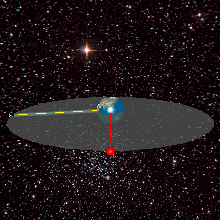 |
| Figure 10b.As an example, too many to list, Wikipedia contributions by Loo Kang are used in many different pages of wikipedia and many different languages as well. http://commons.wikimedia.org/wiki/File:Geostationaryjava3D.gif |
http://creativecommons.org/licenses/by-sa/3.0)], via Wikimedia Commons" style="color:rgb(124, 147, 161)">
Educators and physicists from Singapore and worldwide also benefit from Loo Kang’s many re-purposed from simulation to animation on Wikipedia (Figure 10). His site (http://commons.wikimedia.org/wiki/Special:ListFiles/Lookang) provides a sense of the extent and scale of the impact of his work.
| Figure 11a.Email from This email address is being protected from spambots. You need JavaScript enabled to view it. asking for permission to use Loo Kang’s work on wikipedia on a documentary film about germany’s historic town and historical moments about Clauss Jönsson has performed in 1961 at the University of Tuebingen. Wikipedia post is http://en.wikipedia.org/wiki/Double-slit_experiment |
 |
| Figure 11b.Email from This email address is being protected from spambots. You need JavaScript enabled to view it. asking for permission to use Loo Kang’s work on wikipedia on a documentary film about germany’s historic town and historical moments about Clauss Jönsson has performed in 1961 at the University of Tuebingen. Wikipedia post is http://en.wikipedia.org/wiki/Double-slit_experiment |
As testimony to Loo Kang’s impact, he has received international recognition for his work. A German video company, House of Documentary Films, requested Loo Kang’s permission to use his work for a documentary film about the "Double-slit experiment", which Clauss Jönsson has performed in 1961 at the University of Tuebingen (Figure 11).
| Figure 12.Loo Kang’s analysis were objective and evidence based, using daily affairs to make physics useful to everyday life scenarios serves to make students think for themselves to use evidences to support their claim is the act of being critical and scientific http://weelookang.blogspot.sg/2012/05/what-evidence-of-speed-ferrari-was.html |
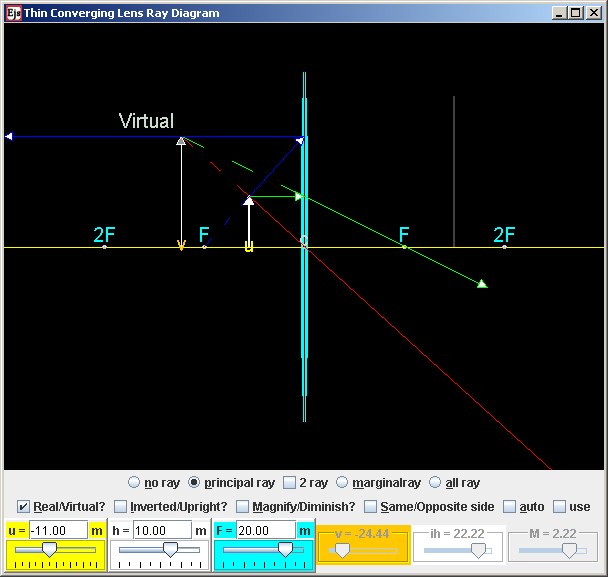 |
| Figure 14a.2 recent computer models (left) thin lens ray diagram requested by RGS teachers and requested by a beginning teacher on Facebook requesting for help from the instructional programme support group (physics) IPSG facebook page that resulted in a computer model about phase difference(right). http://weelookang.blogspot.sg/ has the full range of models. |
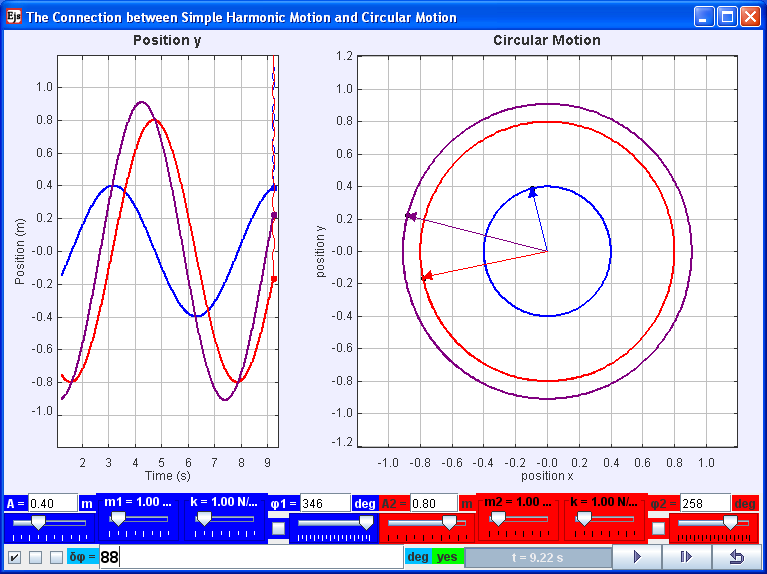 |
| Figure 14b.2 recent computer models (left) thin lens ray diagram requested by RGS teachers and requested by a beginning teacher on Facebook requesting for help from the instructional programme support group (physics) IPSG facebook page that resulted in a computer model about phase difference(right). http://weelookang.blogspot.sg/ has the full range of models. |
Always a champion for authentic learning, Loo Kang was in the Singapore’s media limelight for his analysis of a high profile accident this year. Applying his modeling techniques, he presented an analysis of the speed of the Ferrari 599 GTO which crashed into a Taxi, causing 3 dead, 2 injured at Bugis S'pore on 12May2012. His analysis was showcased in the mass media, for example, Asiaone Motoring,Asiaone News , Stomp (Figure 12) and My Paper (Figure 13). His approach of applying evidence-based analysis to real-life events won accolades by students, teachers and NIE academics as it encouraged students to do likewise. He is always willing to help teachers to create better tools for physics education (Figure 14).Partnership with International Professional Associations He is a member of American Association of Physics Teacher (APPT), GIREP (International Research Group on Physics Teaching) and Multimedia in Physics Teaching and Learning (MPTL) where he actively contributes through the Open Source Physics Group. Below are his conference presentations and curriculum materials on Open Source Physics.
Conferences:
- Wee L.K., Lim A.P., Goh G.S. (2012, 02 July, 1300-1430) Computer Models Design for Teaching and Learning using Easy Java Simulation, Parallel Session 02.09, World Conference on Physics Education Bahçeşehir Üniversitesi, İstanbul, Turkey
- Wee, L. K. (2012, 08 February). Physics Educators as Designers of Simulation Using EJS Part 2. Paper presented at the American Association of Physics Teachers National Meeting Conference: 2012 Winter Meeting, Ontario, California, USA.
- Wee, L. K. (2010, 20 July). Physics Educators as Designers of Simulation using Easy Java Simulation. Paper presented at the American Association of Physics Teachers National Meeting Conference: 2010 Summer Meeting, Portland, Oregon, USA.
Open Source Physics Simulations
- Wee, L. K. (2012). Geostationary Earth Orbit Satellite Model. [Computer software] Retrieved fromhttp://www.compadre.org/Repository/document/ServeFile.cfm?ID=11775&DocID=2634
- Wee, L. K. (2012). Tracker Video Analysis: Bouncing Ball. [worksheet, video and trk file] Retrieved fromhttp://www.compadre.org/Repository/document/ServeFile.cfm?ID=11705&DocID=2583
- Hwang, F.-K., & WEE, L. K. (2011). Direct Current Electrical Motor Model [Computer software].. Retrieved fromhttp://www.compadre.org/Repository/document/ServeFile.cfm?ID=11529&DocID=2476
- Hwang, F.K, & WEE, L.K. (2011). Newton's Cradle Applet [Computer software]. Retrieved July 26, 2011, fromhttp://www.phy.ntnu.edu.tw/ntnujava/index.php?topic=2195.0
- WEE, L.K (2011). Up and Down Bouncing Ball Model [Computer software]. Retrieved April 23, 2011, fromhttp://www.compadre.org/osp/document/ServeFile.cfm?ID=10817&DocID=2186&Attachment=1
- WEE, L.K., & Esquembre, F. (2010). Lorentz force on a current carrying wire java applet [Computer software]. Retrieved April 23, 2011, from http://www.compadre.org/Repository/document/ServeFile.cfm?ID=10543&DocID=2053
- Hwang, F.K., & WEE, L.K. (2010). Cyclotron in 3D Model (Version 10/12/2010) [Computer software]. Retrieved April 23, 2011, from http://www.compadre.org/osp/items/detail.cfm?ID=10527
- Hwang, F.K., WEE, L.K. & Christian, W (2009). Vernier Caliper Model [Computer software]. Retrieved April 23, 2011, fromhttp://www.compadre.org/Repository/document/ServeFile.cfm?ID=9707&DocID=1445
- Hwang, F.K., WEE, L.K. & Christian, W (2009). Micrometer Model [Computer software]. Retrieved April 23, 2011, fromhttp://www.compadre.org/Repository/document/ServeFile.cfm?ID=9422&DocID=1315
- Hwang, F.K. & WEE, L.K (2009). Blackbody Radiation Spectrum Model [Computer software]. Retrieved April 23, 2011, fromhttp://www.compadre.org/Repository/document/ServeFile.cfm?ID=9387&DocID=1292
Awards and Accolades Received
He has also received awards for his ideas and service rendered to the public service.
- Innergy Award Winner 2012 (Gravity-Physics by Inquiry) Gold Award
- Innergy Award Winner 2012 (Bringing Innovative Ideas to Practice Through Propel-T Projects) Gold Award
- Innergy Award Winner School Commendation 2011 (Learning Physics through video analysis RVHS) Commendation Award
- Appreciation Award by Academy of Singapore Teachers 2011
- Public Service Excellence in Service Award (EXSA) Star 2011
- Public Service Excellence in Service Award (EXSA) Gold 2010
- Public Service Excellence in Service Award (EXSA) Silver 2009
Impact: (Original )
Table 1: Benefits of gravity-physics inquiry lesson package showing number of students, teachers and schools in Singapore, contributions to physics education and the world through Wikipedia under the timeline since 2006 to beyond 2014.
| Year | 2006 - 2011 | 2012 - 2013 | 2014 - | |
| Research type: | Pilot –ground-up experimenting | eduLab project | Projected Scaling up | |
| Benefits: | ||||
| Singapore | Students | 20 | 1000 | >4400 |
| Teacher(s) | 1 | 25 | >110 | |
| School(s) | 1 | 5 | >22 | |
| World | Physics Education | Digital libraries at Open Source Physics and NTNU Java Virtual Lab1a. Geostationary Earth Orbit Satellite Model1. Ejs Open Source Geostationary Satellite around Earth Java Applet2. Ejs Open Source Gravitational Field & Potential of 2 Mass Java Applet3. Ejs Open Source Gravitational Field & Potential of Earth and Moon Java Applet4. Ejs Open Source Kepler 3rd Law System Model Java AppletJournal Publications1. Wee L.K., Goh G.H.,Kwan Y.M., Charles Chew (2012) Geostationary Earth Orbit Satellite Model using Easy Java Simulation (under peer review)2. Wee L.K., Goh G.H. (2012) Earth-Moon System using Easy Java Simulation (pending submission) | ||
| Public | List of animations at Wikimedia to support the writing in Wikipediahttp://commons.wikimedia.org/wiki/Special:ListFiles/LookangWikipedia relevant to gravity concepts for example.http://en.wikipedia.org/wiki/Mars Mars's average distance from the Sun is roughly 230 million km (1.5 AU) and its orbital period is 687 (Earth) days as depicted by the red trail, with Earth's orbit shown in blue.(Animation) Mars's average distance from the Sun is roughly 230 million km (1.5 AU) and its orbital period is 687 (Earth) days as depicted by the red trail, with Earth's orbit shown in blue.(Animation) |
|||
Depicted in Table 1: the significant benefits to date for gravity-physics by inquiry lesson package is estimated at 1000 students, 25 teachers facilitating the inquiry pedagogy with computer models in 5 eduLab schools with contributions to digital libraries at Open Source Physics and NTNU Java Virtual Lab and 2 scholarly articles in Physics Education Journal. Public also get to also benefit from his re-purposed animation to support the world’s most popular encyclopedia Wikipedia with millions of users all over the world.
The other significant impact would be to allow students to take on the role of scientists (Jan, Chee, & Tan, 2010) to conduct their own guided inquiry learning for efficient use of curriculum time and promoting self direction as life long learners (MOE, 2009). His solutions substantially address the challenge of allowing students to make sense of and ‘bring’ very large gravity systems such as Solar System Model (Figure 2), Earth and Satellite Model (Figure 3), Two Mass Model science laboratory toolkit (Figure 4) and Moon-Earth Model (Figure 5), into the hands of ordinary students, in any classroom, in any part of the world.
Reference: (Final)
- Adams, W., Reid, S., LeMaster, R., McKagan, S., Perkins, K., Dubson, M., & Wieman, C. (2008). A Study of Educational Simulations Part II--Interface Design. Journal of Interactive Learning Research, 19(4), 551-577.
- Chee, Y. S. (1995). Cognitive Apprenticeship and Its Application to the Teaching of Smalltalk in a Multimedia Interactive Learning Environment. Instructional Science, 23(1-3), 133-161.
- Chee, Y. S., Tan, D. K. C., Tan, E. M., & Jan, M. F. (2009, 24 to 26 November). Learning Chemistry with the game “Legends of Alkhimia”: Pedagogical and Epistemic Bases of Design-for-Learning and the Challenges of Boundary Crossing. Paper presented at the Science Education: Shared Issues, Common Future Proceedings of International Science Education Conference 2009, National Institute of Education, Singapore.
- Christian, W., & Esquembre, F. (2007). Modeling Physics with Easy Java Simulations. Physics Teacher, 45(8), 475-480.
- Christian, W., Esquembre, F., & Barbato, L. (2011). Open Source Physics. Science, 334(6059), 1077-1078. doi: 10.1126/science.1196984
- Collins, A., Brown, J., & Newman, S. (1987). Cognitive Apprenticeship: Teaching the Craft of Reading, Writing, and Mathematics. Technical Report No. 403.
- Duffy, A., & Wee, L. K. (2010a). Ejs Open Source Gravitational Field & Potential of 2 Mass Java Applet, fromhttp://www.phy.ntnu.edu.tw/ntnujava/index.php?topic=1921.0
- Duffy, A., & Wee, L. K. (2010b). Ejs Open Source Gravitational Field & Potential of Earth and Moon Java Applet, fromhttp://www.phy.ntnu.edu.tw/ntnujava/index.php?topic=1924.0
- Gibbons, M. (2002). The Self-Directed Learning Handbook: Challenging Adolescent Students to Excel. The Jossey-Bass Education Series.
- Hake, R. R. (1998). Interactive-engagement versus traditional methods: A six-thousand-student survey of mechanics test data for introductory physics courses. American Journal of Physics, 66(1), 64-74. doi: 10.1119/1.18809
- Hwang, F. K., & Esquembre, F. (2003). Easy java simulations: An interactive science learning tool. Interactive Multimedia Electronic Journal of Computer - Enhanced Learning, 5.
- Jackson, J., Dukerich, L., & Hestenes, D. (2008). Modeling Instruction: An Effective Model for Science Education. [Article]. Science Educator, 17(1), 10-17.
- Jan, M., Chee, Y. S., & Tan, E. M. (2010). Changing Science Classroom Discourse toward Doing Science: The Design of a Game-based Learning Curriculum. Paper presented at the Proceedings of the 18th International Conference on Computers in Education, Putrajaya, Malaysia.
- McDermott, L., Shaffer, P., & Rosenquist, M. (1995). Physics by inquiry: John Wiley & Sons New York.
- MOE. (2010). Opening Address by Mr Heng Swee Keat, Minister for Education, at the Ministry of Education (MOE) Work Plan Seminar, on Thursday, 22 September 2011 at 10.00 am at Ngee Ann Polytechnic Convention Centre. Speeches Retrieved 01 March, 2012, from http://www.moe.gov.sg/media/speeches/2011/09/22/work-plan-seminar-2011.php
- MOE. (2011). Handbook for Teaching Secondary Physics C. Y. Lau, D. J. S. Wong, C. M. K. Chew & J. K. S. Ong (Eds.), Retrieved from http://subjects.edumall.sg/subjects/slot/u1025854/Handbook%20for%20Teaching%20Secondary%20Physics.pdf
- MOE. (2012a). MOE Innergy Awards: MOE Innergy (HQ) Awards Winners : Gold Award :Educational Technology Division and Academy of Singapore Teachers: Gravity-Physics by Inquiry Retrieved 25 May, 2012, from http://www.excelfest.com/award
- MOE. (2012b). Press Releases: eduLab at the Academy of Singapore Teachers (eduLab@AST) to Bring Ideas into Practice Retrieved 25 May, 2012, from http://www.moe.gov.sg/media/press/2012/03/edulab-at-the-academy-of-singa.php
- Plomp, T. (2011, June 12 – 14, 2011). Preparing Education for the Information Society: Curricular and Implementation Challenges. Paper presented at the International Symposium on Educational Reform, East China Normal University, Shanghai, China.
- Scherr, R. E. (2003). An Implementation of Physics by Inquiry in a Large-Enrollment Class. The Physics Teacher, 41(2), 113-118. doi: 10.1119/1.1542051
- Timberlake, T., & Wee, L. K. (2011). Ejs Open Source Kepler 3rd Law System Model Java Applet 1.0. fromhttp://www.phy.ntnu.edu.tw/ntnujava/index.php?topic=2225.0
- Wee, L. K. (2010a, July 17-21). AAPT 2010 Conference Presentation:Physics Educators as Designers of Simulations. Paper presented at the 2012 AAPT Summer Meeting, Portland Oregon USA.
- Wee, L. K. (2010b, 03 November). eduLab mass briefing on possible ideation options for eduLab projects sharing on Easy Java Simulation and Tracker. Jurong Junior College, 2010, from http://weelookang.blogspot.com/2010/10/edulab-mass-briefing-at-jurong-junior.html
- Wee, L. K. (2012a, Feb 4-8). AAPT 2012 Conference Presentation:Physics Educators as Designers of Simulations. Paper presented at the 2012 AAPT Winter Meeting, Ontario CA USA.
- Wee, L. K. (2012b). One-dimensional collision carts computer model and its design ideas for productive experiential learning. Physics Education, 47(3), 301.
- Wee, L. K., Chew, C., Goh, G. H., Tan, S., & Lee, T. L. (2012). Using Tracker as a pedagogical tool for understanding projectile motion. Physics Education, 47(4), 448.
- Wee, L. K., & Esquembre, F. (2010). Ejs Open Source Geostationary Satellite around Earth Java Applet 1.0. fromhttp://www.phy.ntnu.edu.tw/ntnujava/index.php?topic=1877.0
- Wee, L. K., Lee, T. L., & Goh, J. (2011, 10 November). Physics by Inquiry with Simulations Design for Learning Paper presented at the The Academy Symposium, Singapore.
- Wee, L. K., & Mak, W. K. (2009, 02 June). Leveraging on Easy Java Simulation tool and open source computer simulation library to create interactive digital media for mass customization of high school physics curriculum. Paper presented at the 3rd Redesigning Pedagogy International Conference, Singapore.
- Wieman, C. E., Adams, W. K., Loeblein, P., & Perkins, K. K. (2010). Teaching Physics Using PhET Simulations. Physics Teacher, 48(4), 225-227.
- Wieman, C. E., Adams, W. K., & Perkins, K. K. (2008). PhET: Simulations That Enhance Learning. [Article]. Science, 322(5902), 682-683.
Ceremony
PS21 ExCEL Awards Best Ideator 2012
Yes, i am awarded this honor in 2012 thanks to the Open Source Physics community. I have always acknowledged the passionate contributions of Francisco Esquembre, Fu-Kwun Hwang and Wolfgang Christian for their ideas and insights in the co-creation of interactive simulation and curriculum materials. They are the real heroes in Physics Education, my source of inspiration for being an educator :)
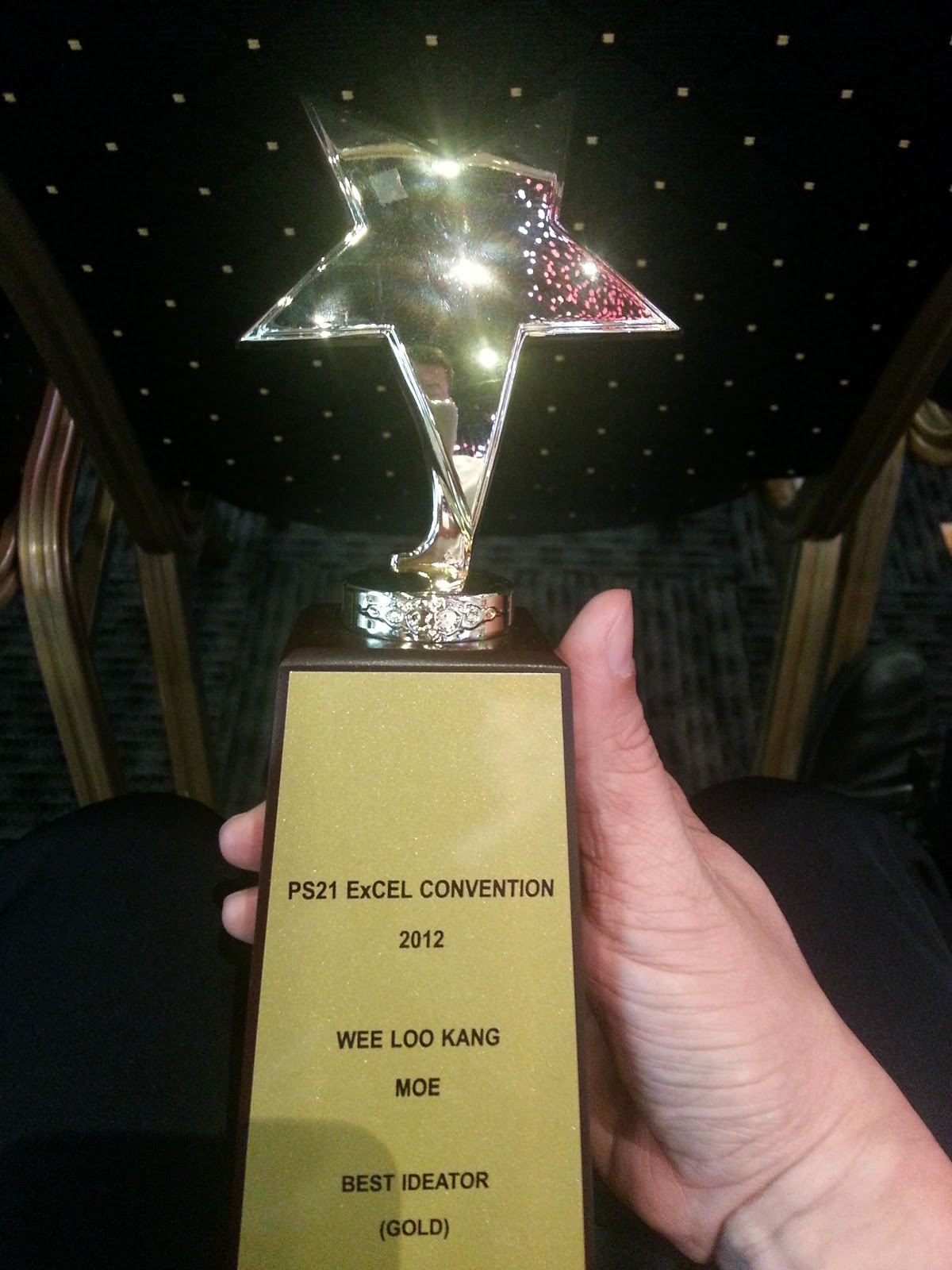 |
| PS21 ExCEL convention 2012 Wee Loo Kang MOE Best Ideator GOLD |
Date: 15 November 2012 (Thurs)
Venue: Gardens by the Bay, Flower Dome (Jubilee Hall)
Facebook page: https://www.facebook.com/pages/PS21-ExCEL-Convention-2012/457877080901703
08.00 am – Registration of Nominees and Awardees
 |
| PS21 ExCEL convention 2012 Wee Loo Kang MOE Best Ideator GOLD, envelope with book \)200 SGD vouchers, useful for my kids reading needs, thanks to the organizers and Kinokuniya Bookstores |
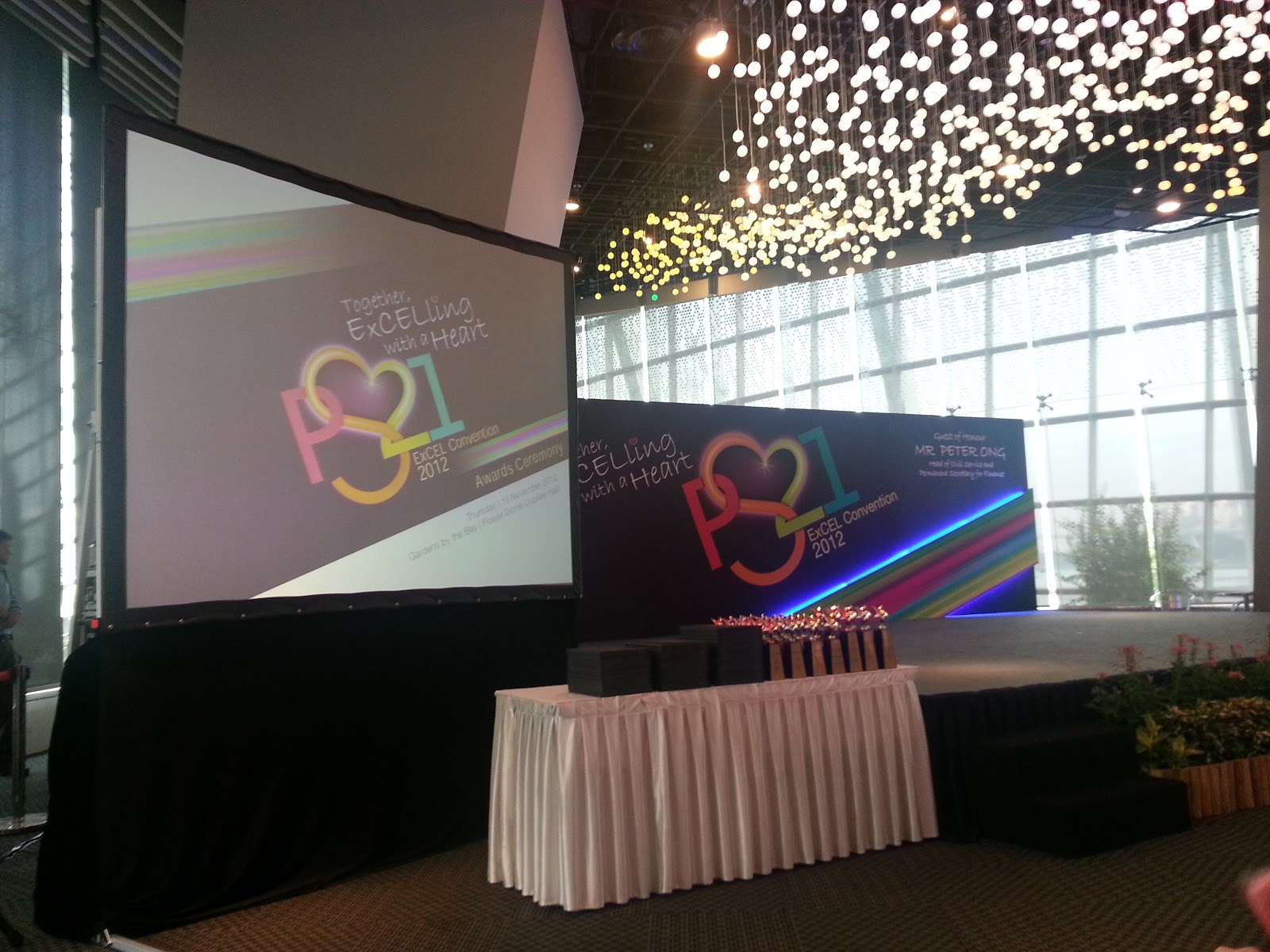 |
||
stage
|
08.30 am – Briefing to Nominees and Awardees (and dry run if time permits)
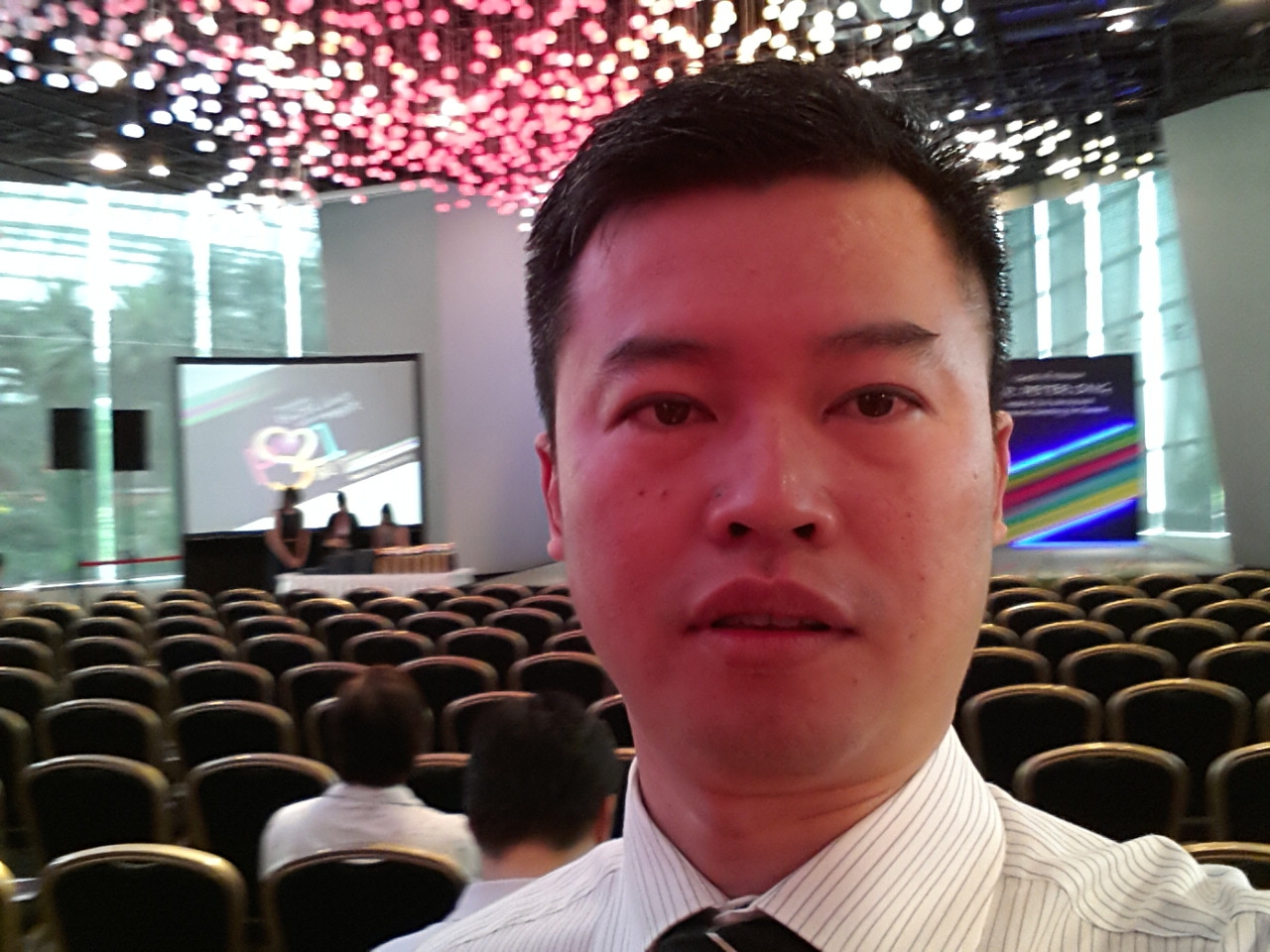 |
| PS21 ExCEL convention 2012 Wee Loo Kang MOE Best Ideator GOLD, testing my Note 2 photo front camera |
09.15 am – All Nominees and Awardees to be seated
10.00 am - Arrival of Guest of Honour, ceremony commences
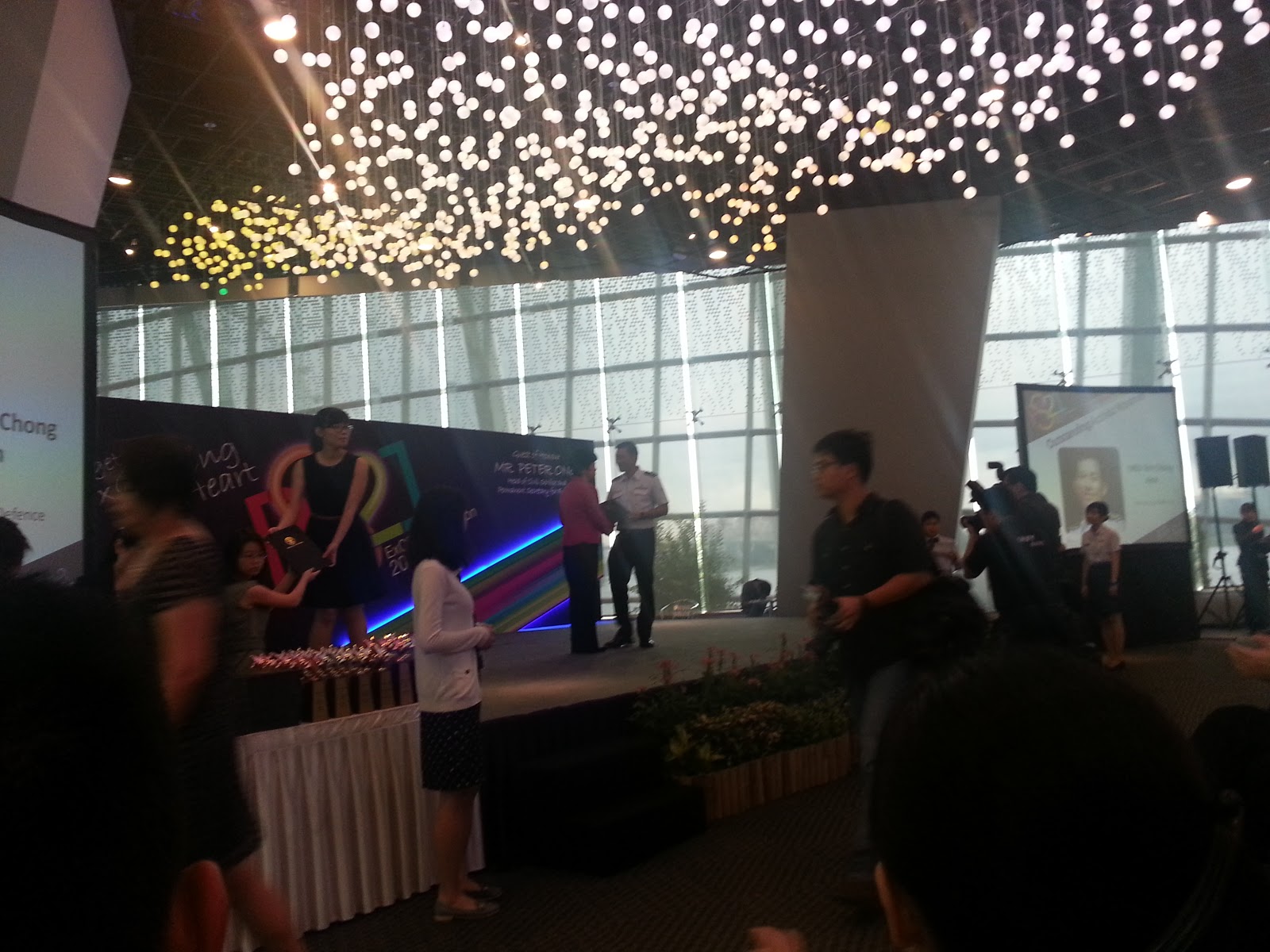 |
| ME6 Teh C.A. my AJC and NUS course mate |
 |
| PS21 ExCEL convention 2012 Wee Loo Kang MOE Best Ideator GOLD |
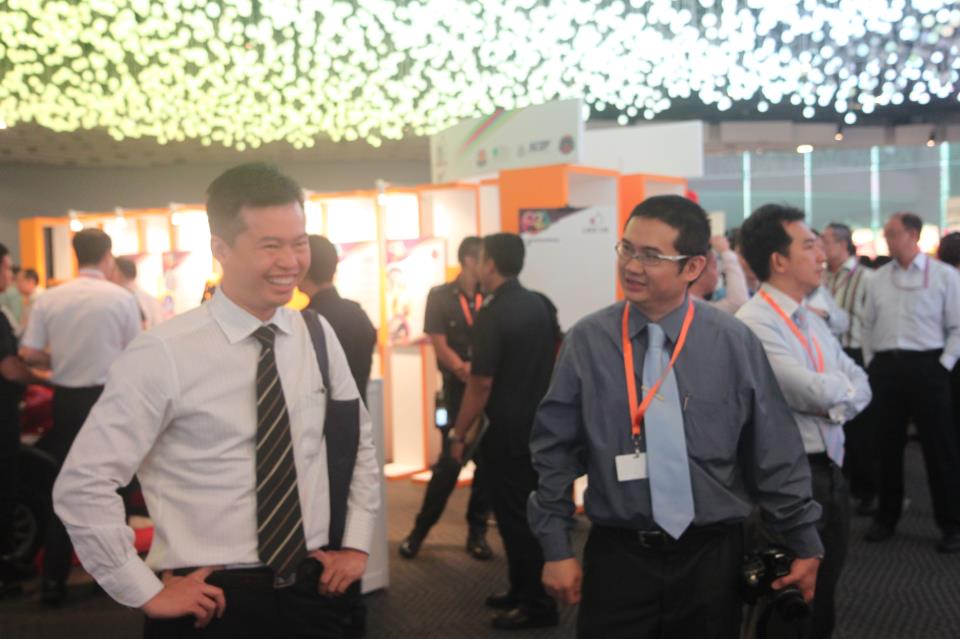 |
| https://www.facebook.com/photo.php?fbid=10151157619032956&set=t.731464494&type=3&theater photo shared by thomas Hunkprasom Chaktiwangcai |
12.20 am – End of Awards Ceremony. All are invited to visit the exhibition hall
01.00 pm – Adjourn to Lunch Reception
 |
| free photo shot by the organizers with Walter, lookang and chong ann. |
I also like to thank Latha setting up my nomination, Yew Meng and Seau Yoon for vetting, Victor of the impact section beefing up.
And Ms Chan for setting a path way for me to ideate and impact education and Dr Cheah for his words about "motivating people by aligning their objectives with the goals of the organization".
I truly believe in this fundamental idea of organizational excellence through Management by Objectives approach so i acted on it using Easy Java Simulation and Tracker.
My advise is go forward and better education the way you see fit, instead of doing organizational or other peoples' project, you have to own it for it to work, you have to believe in what you do, or else it will never work out. Remember that.
Background info:
The PS21 ExCEL Awards are given out every year to recognise innovative ideas and outstanding initiatives by individuals and teams which have had significant impact within and beyond their organisation. This year, each Ministry was invited to nominate deserving individuals in 3 award categories:
- Best ideator - to recognise individuals who have made significant contributions in the areas of ideation and suggestions for improvement. A total of 16 nominees were selected for the award.
- Outstanding Activist
- Best PS21 Project
These awards will be presented to when they attend the PS21 ExCEL Awards Ceremony on 15th November 2012, 10.00am at Gardens by the Bay, Flower Dome Function Space. The Awards Secretariat will contact award recipients separately regarding the administrative details.
reference for the writeup:
http://weelookang.blogspot.sg/2012/07/nomination-for-ps21-excel-awards-best.html
http://excel2012.sg/PS21-ExCEL-Convention-2012
http://www.excel2012.sg/PS21-ExCEL-Convention-Forum-Awards
mass media coverage:
http://www.straitstimes.com/breaking-news/singapore/story/awards-public-sector-projects-20121115
http://app.psd.gov.sg/data/HCS%20Peter%20Ong%20Speech%20at%20PS21%20ExCEL%20Awards%202012.pdf
 |
| PS21 ExCEL Awards 2012, ideator |
 |
| http://www.excel2012.sg/PS21-ExCEL-Convention-Forum-Awards |
MOE Planning Posters
PS21 ExCEL Convention 2012 Posters - Best Ideator
PS21 ExCEL Convention 2012 Posters - Best Ideator
Update 27 dec 2012. Thanks This email address is being protected from spambots. You need JavaScript enabled to view it. !
 |
| PS21 ExCEL Convention 2012 Posters Wee Loo Kang and Richard Han 2012 |
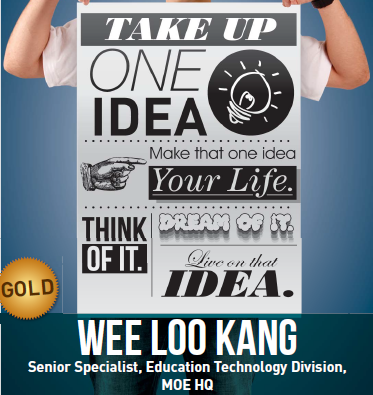 |
| mockup |
Congratulations on winning the PS21 ExCEL Convention Best Ideator (Gold) Award.
We would like to take this opportunity to not only further recognise your efforts but also to seek your help to inspire others on the journey towards innovation and excellence in public service. We plan to do this through specially designed posters which will be displayed in MOE HQ. Please find attached the draft version of the poster which is still a work in progress.
These posters will require your input in the following areas.
(A) Request for inputs to question
Please share your thoughts/views to the following question in no more than 100 words. Please note that we would be summarising/paraphrasing where necessary to cater to space available.
1. Where do you normally get inspiration for your ideas? OR What do you do when you need ideas to solve a problem?
My answer:
Take the idea of free access to quality physics education and the way people learn by doing, the Open Source Physics and Easy Java Simulation projects provides ordinary mortals like teachers and students, a simple way to design their own computational physics simulation-model. Therefore, anyone can freely access, explore, understand, describe, explain, and predict these physics phenomena modeled.
This idea is my life where I think, dream and live Open Source Physics through remixing and re-purposing simulations to meet teachers' and students' learning needs at no additional cost plus creative licensing so that anyone can change the source codes legally.
Please submit your response to me by 16 Nov 2012 (Friday).
(B) Photo Shoot for the Poster
Based on the attached draft poster, we would require a good quality photo of you. We will be arranging for a photo shoot session some time this month and will inform you once the details are confirmed.
Should you have any enquiries please feel free to contact me Aainaa or my colleague Ms Yvonne Chong (This email address is being protected from spambots. You need JavaScript enabled to view it., ). Thank you and once again, our heartiest congratulations to you for winning the award.
MORE MOE Posters
more posters and greetings from the PS21 and Culture Unit team!
sounds like more posters A3 for ETD, A2 for lookang.
Thanks to the
- Aainaa for the email
- Hai Seng for putting up the ETD A3 poster soon :)
- PS21 and Culture Unit team from MOE!
To celebrate your win of the Best Ideator Award at the PS21 ExCEL Convention 2012, we have earlier informed you that we would like to feature you in a poster to be displayed in the lifts at MOE HQ. The purpose of these posters is to not only recognise your efforts but also to serve as an inspiration for others on the journey towards innovation and excellence in public service. We would like to thank you for contributing the quotes as well as taking the time off to come down for the photo shoot session.
We would like your division to recognise your efforts in innovation too! Hence we are happy to inform you that in addition to displaying the posters at MOE HQ lifts, we have printed an A3 size of the Best Ideator Award poster for your division to display.
cc. Mr Seah Hai Seng, we would like to seek your assistance as PS21 Coordinator to display the poster at a prominent area at the division level.
Also we would like you to have a copy of the poster for your keepsake. Therefore we have printed an A2 version of it.
Please note that both the A3 and A2 posters are ready and we would be sending it to you and Mr Seah soon.
Thank you very much and once again our heartiest congratulations!
MOE Publications
http://intranet.moe.gov.sg/orgdevdiv/newsletter/Aspire%20Jan_13.pdf
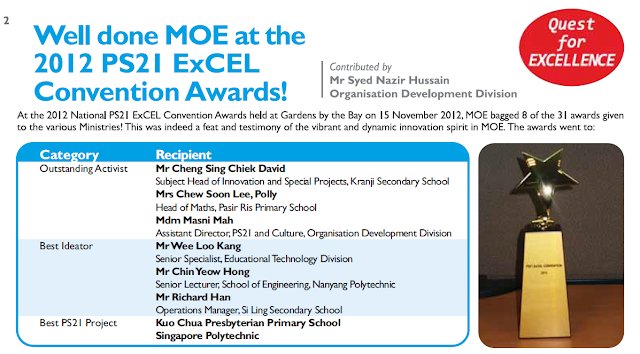 |
| well done MOE at 2012 PS21 ExCEL Convention Awards!, Page 2 in ASPIRE Newsletter - Issue 18 Jan 2013. |
Best Ideator news.Thanks to Syed for the article reporting.
8 of the 31 awards for MOE.
you can read my other blog posts on this
http://weelookang.blogspot.sg/2012/11/ps21-excel-convention-2012-posters-best.html
http://weelookang.blogspot.sg/2012/10/ps21-excel-awards-best-ideator-2012.html
http://weelookang.blogspot.sg/2012/07/nomination-for-ps21-excel-awards-best.html
Challenge Publication One man can make a difference
It was 2006. A video clip that was part of the syllabus was playing but the junior college class watching was struggling to grasp the scientific theories flashed across the screen. At that moment, their physics teacher, Mr Wee Loo Kang, had an epiphany: “This cannot be the right way to get students to learn...and there needed to be a change.”
He explained: “Physics is abstract, and without any tools for [the students] to interact with these phenomena, it’d be practically impossible for them to have a deeper understanding.”

PS21 Best Ideator, Wee Loo Kang, spent five years to develop an award-winning project to make physics more engaging for students.
Keen to create productive and interactive learning tools, Mr Wee, now Senior Specialist at the Ministry of Education (MOE)’s headquarters, began to explore building realistic and well-designed computer simulations. To do this, he tapped the Open Source Physics research community that shares free curriculum resources, allowing users to modify and redistribute source codes. He didn’t have the Java programming skills at first but that didn’t deter him. Mr Wee spent hours of his free time mastering Java with the help of online tutorials and by posting questions to professors across the globe.
His key project Gravity-Physics by Inquiry, which was developed over five years on his own time, won MOE’s top innovation award in 2012. The judges described it as “a fundamental breakthrough in how physics was taught”. For example, in one of the simulation exercises, students are virtually despatched to the Earth’s moon to launch a rocket into space to calculate (and hence experience) the minimum kinetic energy required to escape from the moon’s and Earth’s gravity pull.
Word of Mr Wee’s interactive and engaging teaching methods spread widely. Teachers from five other junior colleges now use his lessons which are shared freely on his blog. So far, Mr Wee has created and adapted more than 65 physics simulations for the Singapore physics curriculum – leading the shift from the standard “drill and practise” approach to an inquiry-based model. Now, the ministry is extending his ideas to the new Teachers’ Handbook for Teaching Secondary Physics.
So if Singapore were to have a surge in the number of physicists, we might have to thank Wee Loo Kang for it.
FAQ: Open Educational Resources and Physics Simulations
- What are Open Educational Resources (OER) in the context of physics education, and why are they significant?
- Open Educational Resources (OER) are freely accessible teaching and learning materials that can be used, adapted, and shared without cost or copyright restrictions. In physics education, OER like computer simulations, lesson plans, and digital tools provide teachers and students with accessible, high-quality resources, breaking down barriers related to cost and location. The significance lies in promoting equitable access to educational materials and fostering innovation through the remixing and repurposing of learning content.
- What is the "Gravity-Physics by Inquiry" project, and what makes it innovative?
- "Gravity-Physics by Inquiry" is a project focused on creating a series of computer models to facilitate investigative data collection, analysis, and visualization of abstract gravity concepts. Its innovation lies in its ability to make otherwise difficult and expensive experiments accessible to students. Instead of requiring costly equipment or dangerous space travel, students can explore realistic physics scenarios through interactive simulations. This includes the ability to manipulate parameters, collect data, and make comparisons using real-world astronomical data. The project transforms passive learning into an active scientific inquiry experience, leading to a more profound understanding of gravity.
- How do computer simulations enhance physics learning compared to traditional methods?
- Computer simulations provide a dynamic and interactive environment that brings physics concepts to life. Unlike traditional methods that often rely on lectures, problem-solving, and static visuals, simulations allow students to actively engage with physics phenomena. They can explore variables, collect data, observe cause-and-effect relationships, and visualize abstract concepts in a concrete way. This interactive approach fosters a student-centric learning environment that promotes deeper understanding, stimulates curiosity, and encourages experimentation, thus transforming the learning experience into a more engaging and effective one.
- What is Easy Java Simulations (EJS), and how does it facilitate the creation of these interactive computer models?
- Easy Java Simulations (EJS) is a free, open-source authoring and modeling tool that allows educators to design their own computational physics simulations without requiring extensive programming knowledge. EJS provides a user-friendly environment to create interactive models by simply describing the physics principles, allowing physics teachers and other users to create high-quality interactive simulations. This enables a community of educators and learners to engage in sharing, remixing, and repurposing educational resources freely, fostering an environment for innovation in teaching materials.
- How have these open educational resources impacted Singaporean schools and students?
- The impact on Singaporean schools and students has been substantial. The lesson packages and computer models created have been used in multiple schools, affecting a large number of students and teachers. The computer models are free of charge and offer a low barrier to adoption, aligning with the Ministry of Education's (MOE) vision of preparing learners for the 21st century. Students are encouraged to take on the role of scientists and conduct their own guided inquiry learning through these simulations. These educational resources have led to measurable educational gains, improved pre- and post-test scores, and have been integrated into the Ministry of Education's teacher handbooks, ensuring wider dissemination and uptake of the innovative teaching methods.
- What is the role of inquiry-based learning in conjunction with computer models?
- Inquiry-based learning, when combined with computer models, empowers students to learn through their own exploration and experimentation. Rather than simply absorbing information, students investigate physics phenomena, collect and analyze data, and draw their own conclusions. The computer models provide a platform for this kind of active learning by enabling students to manipulate parameters, visualize abstract concepts, and test their hypotheses. This approach not only deepens understanding but also enhances critical thinking and problem-solving skills, creating a more authentic learning experience.
- How has this work contributed to the international physics community?
- The work has had a notable impact on the international physics community through open-source sharing and global collaboration. The freely available simulations are hosted on Open Source Physics digital libraries, allowing educators and physicists worldwide to access and utilize them. These resources have also been incorporated into Wikipedia, reaching millions of users, making physics concepts accessible through engaging simulations. Furthermore, scholarly publications in Physics Education Journals, presentations at international conferences, and partnerships with international professional associations demonstrate recognition and impact of the educational research, benefiting educators and learners across the globe. This work inspires others in physics education, demonstrating innovative use of technology for teaching and learning.
- What are some examples of real-world applications and analyses that were made possible through this work?
Beyond the classroom, the work has demonstrated the practical application of physics to everyday situations. For example, the analysis of a high-profile car accident using computer modeling techniques showcased the relevance of physics in real-life scenarios. The ability to use these models for analysing the speed of the vehicle based on the accident evidence provided students, teachers, and the general public the opportunity to grasp real-world relevance and encourages them to develop critical thinking skills. This is a practical demonstration of physics being used beyond academia. This also demonstrates that scientific inquiry is not limited to laboratory experiments but also has a role in understanding and making sense of everyday occurrences, making physics more relevant to a broader audience.



